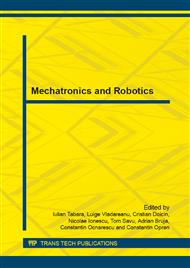p.213
p.219
p.225
p.233
p.243
p.249
p.255
p.261
p.267
Hybrid Analytical Analysis in the Design of Mechatronic Systems
Abstract:
Coupling the structural analysis with the motion analysis in one simulation (hybrid analysis) provides an important mechanism which allows an integrated and optimal approach in the design of mechatronic systems. Such a procedure which includes Matlab/Simulink calculus and visualization of main efforts variation in each structural element of a robot during an entire operational task, allowing coupling structural analysis with motion analysis and testing the virtual prototype on multiple task scenarios is detailed in this paper. Also, the utility of this analysis (information) and ways to improving the control strategy for resources management of an intelligent mechatronic system are emphasized.
Info:
Periodical:
Pages:
243-248
Citation:
Online since:
May 2015
Authors:
Keywords:
Price:
Сopyright:
© 2015 Trans Tech Publications Ltd. All Rights Reserved
Share:
Citation:


